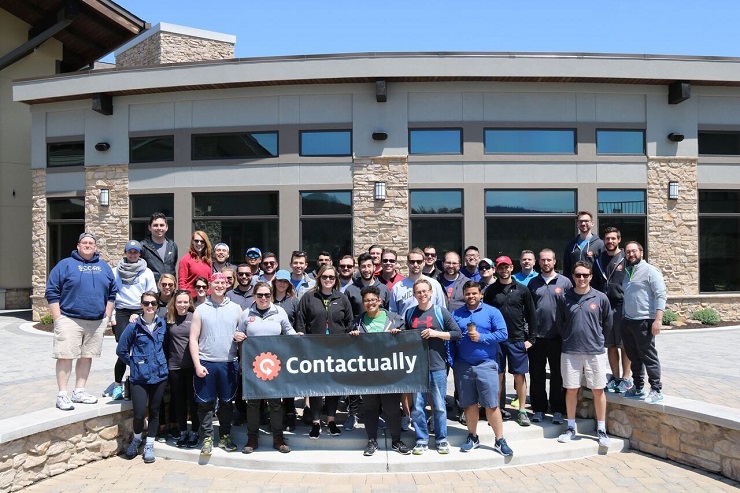Back in ye olden days, the origin stories of tech companies followed a similar formula: Take a visionary college dropout with a dream of changing the world, add a super-nerd obsessed with programming, throw them in a garage or a parent’s basement, and voila. You have a billion-dollar tech giant in the making.
Apple, Microsoft, Dell, and Amazon all have similar stories, but today’s tech startups are born anywhere there’s someone thinking about a problem. That could be in a cubicle, a coffee shop, a teacher’s lounge, behind a cash register, or even on the subway.
All you need is a deep understanding of your prospective customer, an idea to solve one of their problems, and a network you can leverage to validate, build, test, and market that idea.
In other words: no matter your professional background, it’s possible that you have what it takes to become a tech founder—no garage or Ivy League dropout pedigree necessary.
In fact, there’s a good chance that whatever work experience you have in the business world, even if you sometimes feel like a nameless cubicle drone, can take you far as an entrepreneur.
Here’s how you can use your business experience to create your own tech startup, drawing upon wisdom from some of the leading experts we’ve interviewed recently at Foundr.
FREE MASTERCLASS: How To Start a Tech Startup And Get Your First Customer In 60 Days
Networking Skills: Your Most Important Business Asset
First of all, let’s dispel the notion of business relationships being transactional exchanges between people wearing suits.
Most tech startups are ideas that a group of friends come up with and commit to building together. Even if you aren’t well-connected in the tech world, if you have networking skills, you’ll eventually meet someone who can introduce you to someone else.
Zvi Brand, founder and CEO of CRM platform Contactually, passionately believes that the key to any successful venture is in the connections we have to the people around us.
“I was in a room of 100 real estate agents this morning,” Zvi said in a recent interview with Nathan Chan for the Foundr podcast. “Everyone raised their hand when I asked, ‘Okay, who here thinks that their relationships are the most important asset in their business?’ I could have done that to accountants, lawyers, financial advisors, consultants. For them, at the end of the day, you’re not selling a product or widget, you’re selling yourself and your reputation, your skills. Your relationships become all the more important.”
If you belong to a business community or networking group, you’re already one step closer to discovering and building your tech startup idea. Here’s how to apply networking to startup success:
Listen to Your Existing Network to Validate the Problem
Even if you want to solve a problem you’re personally experiencing, you need to validate your problem to see if there’s a demand for a new or better solution in the marketplace.
As a business professional, you already belong to a community you can tap into for insights about how a particular problem affects them.
- Pay attention to what makes your coworkers, peers, and colleagues frustrated
- Spend some time in online discussion groups and invite people to chat about the impact the problem you seek to solve has on their lives.
- Ask what kinds of solutions they’ve tried—what works, what doesn’t, and what could be better
- What problems are they solving for themselves by building spreadsheets or by using several software tools?
Not only will you find out if your startup idea has legs, but you may also discover new dimensions to the problem that you hadn’t anticipated.
All of this listening leads to one of the most important factors in building an excellent tech solution: empathy. The more you understand the people you’re helping, the better you can help them.
Connect With People Who Will Keep You Accountable to Your Goals
Building a tech startup is very different from running your own consultancy or freelancing business. When you work with consulting clients on a per-project basis, they hold you accountable to deadlines and you follow through on tasks out of a need to get paid.
In the early days of a startup, there’s no one to answer to but yourself, and if you lack the discipline to stick to your goals, it’s easy to get sidetracked by more short-term needs like paying the rent.
The best way to avoid straying from your path is to enlist a partner (or two) to help you build your idea and keep you on track. If you don’t have a tech background, find a software engineer or designer to join your mission.
Zvi Brand ended up partnering with a software engineer he had hired for his previous consultancy.
“We were initially just not saying, ‘Hey, do you want to start this company with me?’ But, ‘Hey, I have this idea. Do you want to help me build it?’” Zvi said.
Their third co-founder, Tony Cappaert, was a member of the local tech community but was more business savvy than the two software engineers. He took on a customer development role.
Soon after bringing on Tony, the team raised venture capital.
“The same day we raised venture capital, I closed down my consulting business,” Zvi said.
Develop Relationships With People Willing to Test Your Solution
If you already know that people in your network are experiencing a problem, it’s easier to find people who will test out your solution and provide you with feedback on how to improve it.
Those early testers, also known as innovators, will likely become your biggest advocates as you grow your company.
Why?
A little concept called the Product Adoption Curve. Your tech startup’s early success is very much in the hands of your immediate network of tech enthusiasts, who help kick off a wave of growth through word-of-mouth.
According to Ovi Negrean, co-founder and CEO of socialbee.io:
“Innovators are willing to test your product when it’s still in its infancy. They are OK with bugs and spartan features. But even more importantly, they share their findings with the world and if they like it, they will advocate your product.”
Ovi says without having a solid base of innovators using your product, you’ll never reach the number of users or customers you want and are bound to fail.
Luckily, a massive community of innovators who are keen to try out new products and provide feedback is just a URL away: Product Hunt.
“If you’re starting out and want to get as much traction as possible in the least amount of time and money, Product Hunt can mean the difference between having a struggling business and one that gets thousands of visitors and users in a matter of a week,” Ovi says.
Check out Foundr’s Ultimate Guide to Launching on Product Hunt
FREE MASTERCLASS: How To Start a Tech Startup And Get Your First Customer In 60 Days
Agility: Focus on Solving a Problem, Not Selling a Solution
When you stay focused on a problem, you give your team a mission to solve it, rather than a mission to build a particular solution that may or may not work.
If you have a background in the military, in science, or in the nonprofit world, you know that mission-driven work demands flexibility and a willingness to pivot if necessary.
A design-led tech startup exists to create solutions, and those solutions are delivered as products. Experimentation, feedback, and iteration is an inherent part of the product development process. The product may change drastically throughout its lifetime, but the mission of your company never should.
As someone with a passion for design, Scott Belsky understands the need to “kill his darlings” and adapt ideas to deliver on the mission of his company. His company, Behance, has transformed from a paper company to a live conference for designers and now lives on the web as an online community for creatives to exchange their portfolios.
No matter what form Behance has taken, it’s always sought to keep creatives organized and inspired so they can complete their projects.
“We had to build many incarnations of Behance,” Scott said in his interview for the Foundr podcast. “We’re always improving it, and adding new dimensions to it, and cutting certain dimensions to it, and getting more feedback, and building the business side in terms of the sales for the many lines of revenue we’ve tested over the years of Behance as we’ve built our business.”
Collaboration: Taking Risks, Together
If you look at any tech company’s website, there’s a good chance at some point it will have, in big bold letters the “I-word”: INNOVATION.
Tech startups are built on new ideas, but just because you have an idea doesn’t mean it’s a good one. Likewise, what you think is a bad idea may just be the answer you’ve been looking for.
Clark Valberg, founder and CEO of InVision loves bad ideas. He encourages his team to share ideas, no matter how outlandish, and trust that the people around them will build off of the best parts of it.
“When we find ourselves just backed up creatively, even a little bit, we say ‘bad version,’” Clark told Nathan Chan in his Foundr podcast interview.
“Bad version” is like a permission slip. It’s one that you’re giving to the team and it’s one that you’re also giving to yourself. It’s a contract that states, “What I’m about to say is ****, and that’s OK. It isn’t the final answer. And what I’m looking for from the group around me here is collaboration in the form of helping me and helping us look inside of this answer and look for the best part of it, and add and embellish and dust away the rest.”
Decision-Making: Making the Decision Not to Decide
So far, we’ve discussed the importance of being willing to try out new ideas and listening to the needs of your potential customers—both qualities that are integral to the success of a tech startup. But sometimes, you just have to stop and decide whether or not trying something out, or pursuing a customer segment, is really worth it.
Unfortunately, making decisions can be an uncomfortable task. What if you make the wrong choice and regret it? As your company grows, your decisions impact more than yourself. That’s a lot of pressure.
Wealthfront CEO Andy Rachleff says the best way to alleviate that pressure is to let the people closest to the problem have a voice in the decisions for the company:
Our challenge is to push decision-making as low as possible in the organization. If I’m making decisions, we’re going to fail, because I’m not the closest person to the issue. If you think about the military, if the generals made all the decisions on the field, they would lose. They have to trust their officers and the officers under them to make a call based on what’s going on at the time. So my job is to try to provide context.
Of course, this means that mistakes will happen, and bad decisions sometimes get made, but Rachleff isn’t afraid of a little risk:
When you take risks, you’re going to make mistakes. One of the things I preach to everyone in the company is that you’ve got to make mistakes. Just try not to make the same mistake twice, but it’s totally cool to make mistakes. If we make no mistakes, then we haven’t taken enough risk.
Because without risk, Rachleff truly believes that there will be no reward, or at least no reward worth having.
It’s not about the percentage of things that you do correctly. It’s the magnitude of the things that you do correctly. You might only be right three times out of 10, but if those three things on which you’re right have a big impact, that’s far better than if you’re right 90% of the time on things that have little impact.
These are just a few of the business skills that you can apply to creating a tech startup. If you’re a tech founder, what work experience did you feel helped you create a better startup? Leave a comment below.
FREE MASTERCLASS: How To Start a Tech Startup And Get Your First Customer In 60 Days























